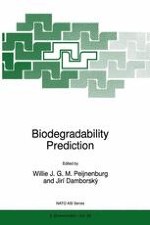1996 | OriginalPaper | Chapter
Development of Structure Biodegradability Relationships (SBRs) for Estimating Half-Lives of Organic Contaminants in Soil Systems
Authors : R. Govind, L. Lei, H. Tabak
Published in: Biodegradability Prediction
Publisher: Springer Netherlands
Included in: Professional Book Archive
Activate our intelligent search to find suitable subject content or patents.
Select sections of text to find matching patents with Artificial Intelligence. powered by
Select sections of text to find additional relevant content using AI-assisted search. powered by
Knowledge of half-lives or biodegradation rate constants in soil is useful for estimating the natural attenuation rates of contaminants due to microbial transformations and to make decisions regarding treatment action or no treatment with isolation of the contaminated site to minimize exposure to animal and human life. Half-life is defined as the time required for 50 % of the contaminant to be biodegraded. Soil treatment is time consuming and expensive, and often for large isolated contaminated sites, relying on natural attenuation may be the most cost-effective solution. In this paper, a neural network is trained to estimate the range of half-lives for organic contaminants in soil. Soil half-life data, obtained from the literature for 258 chemicals is correlated with 14 molecular fragments or indicators using a back-propagation neural network with 14 input nodes, 12 nodes in the hidden layer and 2 output nodes. A cross-validation method was used to test the neural network. The converged neural network produced less than 50 % relative error for more than 80 % of the chemicals in the training set. Using a classification scheme of fast (half-life range of 1 to 7 days), moderately fast (half-life range from 7 to 28 days), slow (half-life range from 28 to 180 days) and resistant (half-life range from 180 to 365 days), the neural network was able to correctly classify more than 95 % of the 258 chemicals in the database.
